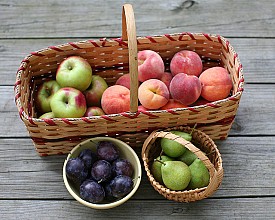How to Keep Summer Fruit Fresh After You Bring it Home
 Tis the season when open air markets and farm stands are full to bursting with delectable fresh fruit. Blueberries, nectarines, currants, figs, and the rest of summer's harvest all look so tempting that you may end up with more than you can use up in just a day or two. So how do you keep your bountiful haul of fresh fruit fresh?
Tis the season when open air markets and farm stands are full to bursting with delectable fresh fruit. Blueberries, nectarines, currants, figs, and the rest of summer's harvest all look so tempting that you may end up with more than you can use up in just a day or two. So how do you keep your bountiful haul of fresh fruit fresh?
General Tips
Unblemished produce is your best bet for storage. This means free of cracks, bruises, and soft spots -- not the surface bumps or blotches that you might find in cosmetically less-than-perfect organic crops.
Wash fruit only a short time before you plan to eat it … but then rinse even produce that will be peeled. Bacteria can easily be transferred from the skin of, say, a melon to its flesh unless you take precautions.
Different houses have different indoor climates. Advice to store food at room temperature often assumes that you operate your air conditioning throughout the summer. However, environmentally aware householders may choose to conserve energy by limiting A/C use and substituting an alternative cooling method, such as an evaporative cooler or an electric fan. These will help keep you comfortable, but they won't do a whole lot for your fruit. In this case, you might well be better off storing it in the refrigerator. Experiment and see what works at your home's summer temperature.
What to Keep Cold
Any cut fresh fruit should be refrigerated promptly. Leaving it at room temperature for longer than two hours total encourages the growth of food-borne pathogens. Play it safe by adding leftovers from a fruit plate to your compost heap.
Grapes tend to spoil quickly (and also attract fruit flies if they are left out) so they should be stored in the refrigerator, in a container that lets them breathe. Even better, wash and freeze for a delightfully frosty snack.
Cherries should also be refrigerated, unwashed and with stems left on, to keep them sweet and tasty for a longer period. (In my home, though, long-term storage of cherries is really unnecessary, as they are gobbled up within a day or so.)
On the other hand, melons may turn mushy with refrigeration and should be kept on your kitchen countertop, out of direct sunlight, for up to 5 days.
Pears are unusual in that they are one of the few types of fruit that will continue to ripen while stored inside the refrigerator. So if you are planning to have them around for a couple of weeks, put them in your crisper. If you'll eat them up quickly, they will do just fine at kitchen temperature.
What to Keep Dry
Peaches, apricots, nectarines, and plums can be softened if you buy them underripe. Store in a paper bag at room temperature for 2-3 days, checking occasionally. (The bag absorbs moisture, which prevents fruits rotting before they ripen, and can be reused for as many batches as you like.) It's advisable to actually eat these delectable stone fruits at room temperature as well, so that their natural aromatics are fully released.
Strawberries, raspberries, and the like are fragile, but will last surprisingly well if they are kept dry as well as cool. Sort through berry baskets and pick out any that are oozing juice. As long as these are not moldy, you can use them right away for a few jars of refrigerator jam or the freshest, most flavorful sherbet imaginable, even if you don't own an ice cream maker. (See below for sherbet recipe.*) Refrigerate intact berries in an uncovered bowl, loosely wrapped in a cotton kitchen towel.
* SIMPLE SHERBET
2 cups very ripe berries, crushed
1 cup water
1/2 cup coconut sugar or alternative sweetener
1 - 2 tsp. lemon juice
Mix and freeze in an ice cream maker. OR pour into a freezer container. Freeze, stirring and scraping down the sides every hour until solid. Remove from freezer 20 minutes before serving.
Laura Firszt writes for networx.com.
Looking for a Pro? Call us (866) 441-6648

Heating & cooling Average Costs
HVAC Contractors Experiences

Kitchen Faucet Replacement With A Unique New Feature

Look To Your Electrician For Advice On The Best Lighting System



